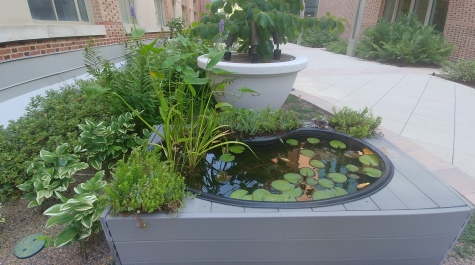Mesocosm ecology
The ponds in this courtyard are more than just decorative—they’re tiny, thriving ecosystems. Each pond contains plants, invertebrates like snails and larval dragonflies, a few goldfish, and, on occasion, frogs. In ecology, these ponds are known as “mesocosm.” That means each one is a small, semi-natural community that mimics the kinds of biological communities you’d find in the wild.
A biological community is simply a group of different species living and interacting in one place. The setup here is modeled after the small, permanent ponds common in wet areas across the Eastern United States. In those natural settings, invertebrates, algae, and fungi colo nize ponds on their own, just as they do here. Frogs and fish may also appear, depending on the conditions.Ecologists use another concept to describe how the species in these ponds are organized: metapopulations. A metapopulation is made up of separate populations of the same species, each living in its own pond but close enough that individuals can sometimes move between them. In the wild, many species are divided into metapopulations like this. Most individuals spend their entire lives in a single pond, but every so often, one will travel—or be carried—to a neighboring pond. Sometimes a species might disappear entirely from one pond, only for that pond to be recolonized later by newcomers from another.
nize ponds on their own, just as they do here. Frogs and fish may also appear, depending on the conditions.Ecologists use another concept to describe how the species in these ponds are organized: metapopulations. A metapopulation is made up of separate populations of the same species, each living in its own pond but close enough that individuals can sometimes move between them. In the wild, many species are divided into metapopulations like this. Most individuals spend their entire lives in a single pond, but every so often, one will travel—or be carried—to a neighboring pond. Sometimes a species might disappear entirely from one pond, only for that pond to be recolonized later by newcomers from another.
Backyard ponds like these can play different ecological roles depending on the species. Some ponds act as “sources”—they produce more individuals than they receive, sending out animals to other locations. Others are “sinks”—they attract animals, but conditions aren’t right for survival or reproduction, so populations there eventually dwindle. The same pond might be a source for one species but a sink for another.
Take the American Bullfrog, native to the Eastern USA, as an example. Young bullfrogs might move into small backyard ponds, grow up there, and then head back to a larger breeding pond as adults. In this case, the backyard pond is a source: it helps raise frogs that later boost the population elsewhere. But if a pond is easy pickings for predators like owls or neighborhood cats, it becomes a sink—frogs keep moving in, but few ever survive to leave. So, whether a pond helps a species thrive or not depends on the species and the specific conditions in and around the pond.
 Skip to main content
Skip to main content
